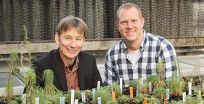(Press-News.org) CHAMPAIGN, Ill. -- When munched by grazing animals (or mauled by scientists in the lab), some herbaceous plants overcompensate - producing more plant matter and becoming more fertile than they otherwise would. Scientists say they now know how these plants accomplish this feat of regeneration.
They report their findings in the journal Molecular Ecology.
Their study is the first to show that a plant's ability to dramatically rebound after being cut down relies on a process called genome duplication, in which individual cells make multiple copies of all of their genetic content.
Genome duplication is not new to science; researchers have known about the phenomenon for decades. But few have pondered its purpose, said University of Illinois animal biology professor Ken Paige, who conducted the study with postdoctoral researcher Daniel Scholes.
"Most herbaceous plants - 90 percent - duplicate their genomes," Paige said. "We wanted to know what this process was for."
In a 2011 study, Paige and Scholes demonstrated that plants that engage in rampant genome duplication also rebound more vigorously after being damaged. The researchers suspected that genome duplication was giving the plants the boost they needed to overcome adversity.
That study and the new one focused on Arabidopsis thaliana, a plant in the mustard family that often is used as a laboratory subject. Some Arabidopsis plants engage in genome duplication and others don't. Those that do can accumulate dozens of copies of all of their chromosomes in individual cells.
In the new study, Scholes crossed Arabidopsis plants that had the ability to duplicate their genomes with those that lacked this ability. If the relationship between DNA duplication and regeneration was mere happenstance, the association between the two should disappear in their offspring, Scholes said.
"But the association persisted in the offspring," he said. "That's the first line of evidence that these two traits seem to be influencing each other."
To further test the hypothesis, Scholes experimentally enhanced an Arabidopsis plant's ability to duplicate its genome. He chose a line that lacked that ability and that also experienced a major reduction in fertility after being grazed.
As expected, the altered plant gained the ability to vigorously rebound after being damaged, the researchers reported.
"We were able to completely mitigate the otherwise detrimental effects of damage," Scholes said. "There was no difference in fertility between damaged and undamaged plants."
Genome duplication enlarges cells and provides more copies of individual genes, likely increasing the production of key proteins and other molecules that drive cell growth, Scholes said. Future studies will test these ideas, he said.
INFORMATION:
The National Science Foundation and U. of I. Research Board funded this research.
Editor's notes:
To reach Ken Paige, call 217-244-6606; email k-paige@illinois.edu.
To reach Daniel Scholes, email scholes2@illinois.edu.
The paper, "Plasticity in ploidy underlies plant fitness compensation to herbivore damage," is available online or from the U. of I. News Bureau.
November 11, 2014--In recent years, many lakes in the upper Midwest have been experiencing unprecedented algae blooms. These blooms threaten fish and affect recreational activities. A key culprit implicated in overgrowth of algae in lakes is phosphorus (P). Lake Pepin, located on the Minnesota/Wisconsin border, has seen increasing phosphorus concentrations over time. Researchers are now trying to identify upstream factors that could explain this increase.
Satish Gupta, a University of Minnesota professor, and Ashley Grundtner, recently published a paper about their research ...
Washington, D.C.--A two-person team of Carnegie's Scott Sheppard and Chadwick Trujillo of the Gemini Observatory has discovered a new active asteroid, called 62412, in the Solar System's main asteroid belt between Mars and Jupiter. It is the first comet-like object seen in the Hygiea family of asteroids. Sheppard will present his team's findings at the American Astronomical Society's Division of Planetary Sciences meeting and participate on Tuesday, November 11, in a press conference organized by the society.
Active asteroids are a newly recognized phenomenon. 62412 ...
How close you are to fast-food outlets may be linked to your risk of Type-2 diabetes and obesity a new study led by the University of Leicester has discovered.
The research found that there was a higher number of fast-food outlets within 500 metres of inner-city neighbourhoods described as non-white as well as in socially deprived areas.
The researchers warn that their findings, based on a study of over 10,000 people, have important implications for diabetes prevention and for those granting planning permission for fast-food outlets.
"Our study suggests that for every ...
Like a skin, the sea-surface microlayer separates the ocean from the atmosphere. The exchange of gases and the emission of sea-spray aerosols - two functions that are crucial for climate - take place in this boundary film. A mesocosm experiment by scientists from GEOMAR Helmholtz Centre for Ocean Research Kiel, Alfred Wegener Institute, Helmholtz Centre for Polar and Marine Research Bremerhaven (AWI) and the Institute for Baltic Sea Research Warnemünde (IOW) reveals for the first time how ocean change might affect the special physical, chemical and biological characteristics ...
Using community pharmacies to identify undiagnosed cases of chronic obstructive pulmonary disease (COPD) at an early stage could save £264 million a year according to new research from the University of East Anglia (UEA).
A report published today shows the value of pharmacies in addressing diseases at an early stage. It reveals that case-finding would provide "significant NHS and societal benefits" and save the NHS more money than the service costs to deliver.
The research shows that more than half (57 per cent) of people screened by pharmacies were identified ...
A tool to help multinational companies assess the business bribery risks faced when conducting business in foreign countries and tailor compliance policies to address those threats has been created by researchers from the RAND Corporation and TRACE International.
Called the TRACE Matrix, the tool improves upon previous methods of risk assessment by incorporating approaches that are better designed to help businesses predict bribery risk and similar threats, researchers say. The tool is free and is available on the TRACE International website.
Researchers say corruption ...
CLEVELAND, Ohio (Monday, November 10, 2014)--After menopause and before age 65, women who have normal bone density have a very low risk of fracture, shows a new study from the Women's Health Initiative (WHI) published online in Menopause, the journal of The North American Menopause Society. That means these women don't need another bone mass density (BMD) test before age 65.
This study followed up 4,068 postmenopausal women ages 50 to 64 who had a BMD test, weren't taking hormones or calcium and vitamin D supplements in the trial, and didn't already have an osteoporotic ...
Research during the past 30 years has found many benefits of skin-to-skin contact between mothers and newborns immediately after birth, particularly with aiding breastfeeding. However, in some hospitals, skin-to-skin contact following cesarean birth is not implemented, due to practices around the surgery. A recent Quality Improvement (QI) project demonstrated that women's birth experiences were improved by implementing skin-to-skin contact after cesarean surgery.
Women who give birth by cesarean often have more difficulty with breastfeeding, and skin-to-skin contact can ...
Consumers place great faith in weight loss pills and remedies, buying and using them more than ever before. American obesity rates, however, are skyrocketing. According to a new study in the Journal of Public Policy & Marketing, false beliefs about these drugs are causing Americans to gain more weight.
"Weight management remedies that promise to reduce the risks of being overweight may undermine consumer motivation to engage in health-supportive behaviors," write authors Lisa E. Bolton (Pennsylvania State University), Amit Bhattacharjee (Dartmouth College) and Americus ...
Why do some chemical farmers resist a profitable conversion to organic methods? A new study in the Journal of Marketing suggests it may be because making that change feels like switching belief systems.
"The ideological map of American agriculture reveals an unfolding drama between chemical and organic farming," write authors Melea Press (University of Bath), Eric Arnould (Southern Denmark University), Jeff Murray (University of Arkansas) and Katherine Strand (McGill University). "Chemical farmers argue that to make money, one must follow chemical traditions; when organic ...



